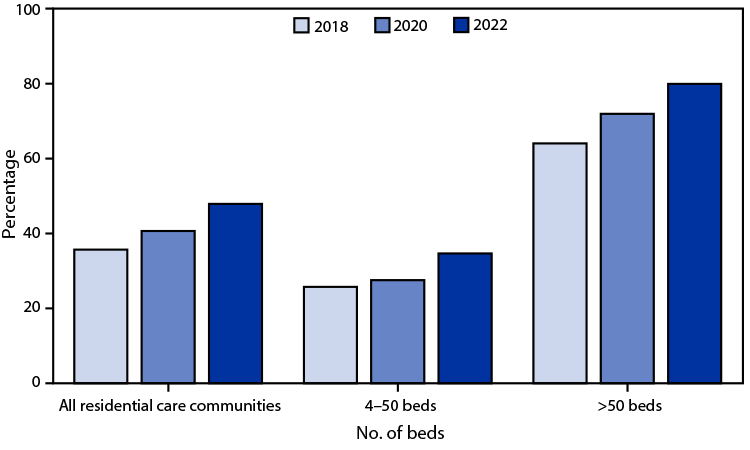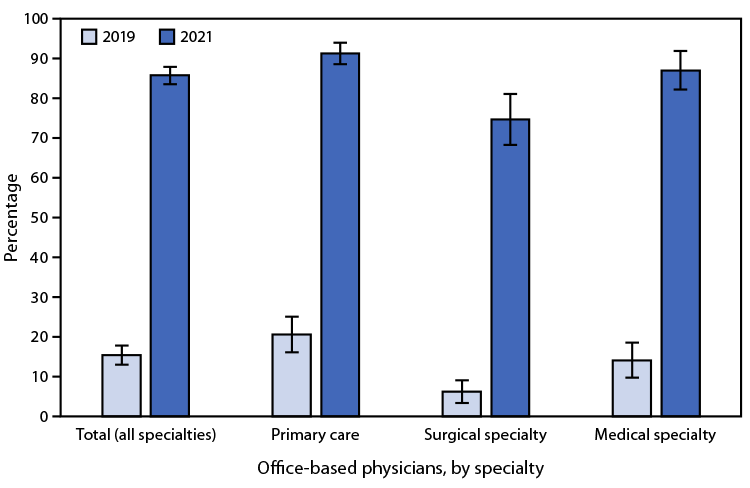Category: electronic medical records
QuickStats: Percentage of Residential Care Communities That Use Electronic Health Records, by Community Bed Size — United States, 2018, 2020, and 2022

From 2018 to 2022, the percentage of residential care communities (RCCs) using electronic health records (EHRs) increased from 36% to 48%. Use of EHRs increased during this time regardless of RCC size, and larger RCCs were more likely to use EHRs compared with smaller RCCs. Supplementary Table: https://stacks.cdc.gov/view/cdc/153378 Source: National Center for Health Statistics, National Post-acute and Read More >
Posted on byQuickStats: Percentage of Office-Based Physicians Using Telemedicine Technology, by Specialty — United States, 2019 and 2021

From 2019 to 2021, the use of telemedicine technology increased for office-based physicians from 15.4% to 85.9%. In both 2019 and 2021, the use of telemedicine technology was higher among primary care physicians and medical specialty physicians than it was among surgical specialty physicians. In 2021, 91.4% of primary care physicians, 87.2% of medical specialty Read More >
Posted on byQuickStats: Distribution of Hours per Day That Office-Based Primary Care and Specialist Care Physicians Spent Outside Normal Office Hours Documenting Clinical Care in Their Medical Record System — United States, 2019
In 2019, 91.0% of office-based physicians spent time outside normal office hours documenting clinical care: 17.0% spent <1 hour, 41.4% spent 1–2 hours, 24.0% spent >2 hours–4 hours, and 8.6% spent >4 hours per day. The percentage of primary care physicians who spent no hours per day documenting clinical care (5.3%) was lower than the Read More >
Posted on byQuickStats: Management of Patient Health Information Functions Among Office-Based Physicians With and Without a Certified Electronic Health Record (EHR) System
In 2018, 78.7% of office-based physicians had a certified electronic health record (EHR) system. A higher percentage of office-based physicians with a certified EHR system compared with those without a system electronically sent (95.5% versus 72.8%), received (95.3% versus 69.0%), integrated (92.8% versus 67.4%), or searched for (90.5% versus 73.3%) patient health information. Source: National Electronic Read More >
Posted on byTrends in electronic health records use among residential care communities: United States 2012, 2014, and 2016
Questions for Christine Caffrey Health Statistician and Lead Author of “Trends in electronic health records use among residential care communities: United States 2012, 2014, and 2016.” Q: Why did you decide to focus on electronic health records use and support for health information exchange among residential care communities? CC: Since how health information is organized Read More >
Posted on byPatient Health Information Shared Electronically by Office-based Physicians: United States, 2015
Questions for Brian Ward, Health Statistician and Lead Author of “Patient Health Information Shared Electronically by Office-based Physicians: United States, 2015” Q: Why did you decide to focus on office-based physicians who electronically share patient health information (PHI) in the United States? BW: While previous research has looked at the extent to which office-based physicians Read More >
Posted on byQuickStats: Percentage of Residential Care Communities That Use Electronic Health Records by Census Region — United States, 2016
In 2016, 26% of residential care communities used electronic health records (EHRs). The percentage that used EHRs was 36% of communities in the Northeast, 41% of communities in the Midwest, 24% of communities in the South, and 17% of communities in the West. Source: National Study of Long-Term Care Providers, 2016 data. https://www.cdc.gov/nchs/nsltcp/index.htm. https://www.cdc.gov/mmwr/volumes/67/wr/mm6725a8.htm Read More >
Posted on byQuickStats: Percentage of Residential Care Communities That Use Electronic Health Records, by Community Bed Size — United States, 2016
In 2016, one fourth (26%) of residential care communities used electronic health records (EHRs). The percentage of communities that used EHRs increased with community bed size. The percentage was 12% in communities with 4–10 beds, 28% with 11–25 beds, 35% with 26–50 beds, 43% with 51–100 beds, and 50% with more than 100 beds using Read More >
Posted on byCharacteristics of Primary Care Physicians in Patient-centered Medical Home Practices: United States, 2013
Questions for Esther Hing, Survey Statistician and Lead Author on “Characteristics of Primary Care Physicians in Patient-Centered Medical Home Practices: United States, 2013” Q: Can you define what a patient-centered medical home (PCMH) practice is? EH: One of several PCMH definitions is that PCMHs provide care that is: comprehensive care provided by a team of providers, Read More >
Posted on byQ & A from Lead Author of “State Variation in Electronic Sharing of Information in Physician Offices: United States, 2015”
Questions for Eric Jamoom, Research Scientist Officer at the Collaborating Center for Questionnaire Design and Evaluation Research and Lead Author on “State Variation in Electronic Sharing of Information in Physician Offices: United States, 2015.” Q: What findings in the report surprised you and why? EJ: In this data brief, we are capturing for the first time Read More >
Posted on byState Variation in Electronic Sharing of Information in Physician Offices: United States, 2015
The Health Information Technology for Economic and Clinical Health Act (HITECH) provides financial incentives to eligible providers using a certified electronic health record (EHR) system. In 2015, 77.9% of office-based physicians had a certified EHR system, up from 74.1% in 2014. A federal plan to enhance the nation’s health information technology infrastructure was published in 2015 to support information Read More >
Posted on byQuickStats: Percentage of Physicians Who Have Electronic Access to Patient Health Information from Outside Their Medical Practice by State
In 2015, approximately half (50.3%) of the physicians in the United States had information from other providers outside of their practice electronically available at the point of care. There was wide variation by state, ranging from 34.6% in Idaho to 76.4% in South Dakota. Sixteen states and the District of Columbia were in the range Read More >
Posted on byCertified EHR Systems in Physician Offices Increase
The Health Information Technology for Economic and Clinical Health Act of 2009 provides incentive payments to eligible hospitals and providers that demonstrate the meaningful use of a certified electronic health record (EHR) system. In 2010, the Office of the National Coordinator for Health Information Technology began certifying EHR systems as having the capabilities that could Read More >
Posted on byProgress With Electronic Health Record Adoption
The Health Information Technology for Economic and Clinical Health (HITECH) Act of 2009 provides incentive payments to eligible hospitals and providers that demonstrate the meaningful use of a certified electronic health record (EHR) system. A new report describes the adoption of EHRs in hospital emergency departments (EDs) and outpatient departments (OPDs) from 2006 through 2011 using Read More >
Posted on byElectronic Health Record Adoption Continues to Climb
While adoption of electronic health record (EHR) systems has grown rapidly, little is known about physicians’ perspectives on its adoption and use. Nationally representative survey data from 2011 are used to compare the perspectives of physicians who have adopted EHRs with those that have yet to do so across three key areas: the impact of Read More >
Posted on byPhysician Experience With Electronic Health Record Systems
A new report from NCHS looks at Electronic Health Record (EHR) systems that meet the meaningful use criteria have specific capabilities associated with efficient and high-quality patient care. The criteria is set by the Centers for Medicare & Medicaid Services. Key Findings from the Report: About three-quarters of physicians with electronic health record systems have systems that Read More >
Posted on byElectronic Health Record Usage in Residential Care Communities
A new report released by NCHS looks at how effective electronic health records are in residential care communities, such as assisted living facilities and similar residential care communities. Although research has been done in other health care settings, little has been focused on residential care communities’ use of electronic health records and their support for Read More >
Posted on byElectronic Medical Records (EMR)
New report shows EMR are being used by more office-based physicians than ever. In 2006, 29.2 % of office-based physicians reported using full or partial EMR systems, this shows an increase of 22% since 2005 and 60% increase since 2001. See full report here! Read More >
Posted on by 3 Comments
